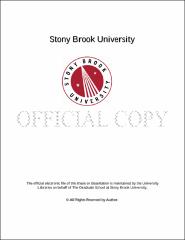| dc.identifier.uri | http://hdl.handle.net/11401/77487 | |
| dc.description.sponsorship | This work is sponsored by the Stony Brook University Graduate School in compliance with the requirements for completion of degree. | en_US |
| dc.format | Monograph | |
| dc.format.medium | Electronic Resource | en_US |
| dc.language.iso | en_US | |
| dc.publisher | The Graduate School, Stony Brook University: Stony Brook, NY. | |
| dc.type | Dissertation | |
| dcterms.abstract | I present a new universal data acquisition system for application for fluorescence detection in life sciences. The system is based on fiberized spectrometer bench with multichannel single photon sensor. Two different spectrometers were designed and tested. One is based on 32 channels PMT and another based on fiberized array of 48 avalanche photo diodes. The developed detection system was tested for three different applications including: DNA sequencing, detection of color encoded beads and fluorescence activated bead sorting. The system is capable of detecting multicolor fluorescence produced by mixtures of fluorescent dyes as well as by micro and nano-objects. In the system, the analyzed sample is forced into the capillary by applying either air pressure or electric field. When the sample passes through a detection area, a laser beam induces multi-color fluorescence. Polychromatic fluorescence is collected by a fiber and directed to the single photon spectrometer. The spectrometer performs color separation and the measurement of fluorescence in the range of wavelengths from 480nm to 720nm. The fluorescence which comes to the spectrometer through the input fiber is coupled to a collimator which produces a parallel polychromatic beam of 10mm diameter. The parallel beam passes through laser rejection filters and undergoes separation on the diffraction grating into constituent wavelength components. The decomposed polychromatic light is received by a multi-channel single photon sensor. The obtained photon count is transferred to computer for recording and data processing. The unique combination of fluorescent dyes with known spectra is recognized in each individual measurement by using color deconvolution of the dye's spectra. The developed fluorescence detection system can be used in wide variety of devices for molecular diagnostics and medicine. | |
| dcterms.available | 2017-09-20T16:52:48Z | |
| dcterms.contributor | Donetski, Dmitri | en_US |
| dcterms.contributor | Gorfinkel, Vera | en_US |
| dcterms.contributor | Shterengas, Leon | en_US |
| dcterms.contributor | Beznosko, Dmitriy. | en_US |
| dcterms.creator | Tovkach, Ivan | |
| dcterms.dateAccepted | 2017-09-20T16:52:48Z | |
| dcterms.dateSubmitted | 2017-09-20T16:52:48Z | |
| dcterms.description | Department of Electrical Engineering. | en_US |
| dcterms.extent | 85 pg. | en_US |
| dcterms.format | Application/PDF | en_US |
| dcterms.format | Monograph | |
| dcterms.identifier | http://hdl.handle.net/11401/77487 | |
| dcterms.issued | 2015-08-01 | |
| dcterms.language | en_US | |
| dcterms.provenance | Made available in DSpace on 2017-09-20T16:52:48Z (GMT). No. of bitstreams: 1
Tovkach_grad.sunysb_0771E_11698.pdf: 9080962 bytes, checksum: b538a4c4e6a3a592ea934156ec54ded9 (MD5)
Previous issue date: 2013 | en |
| dcterms.publisher | The Graduate School, Stony Brook University: Stony Brook, NY. | |
| dcterms.subject | Electrical engineering | |
| dcterms.title | Design of ultra-sensitive fluorescence detection system for applications in molecular biology. | |
| dcterms.type | Dissertation | |

